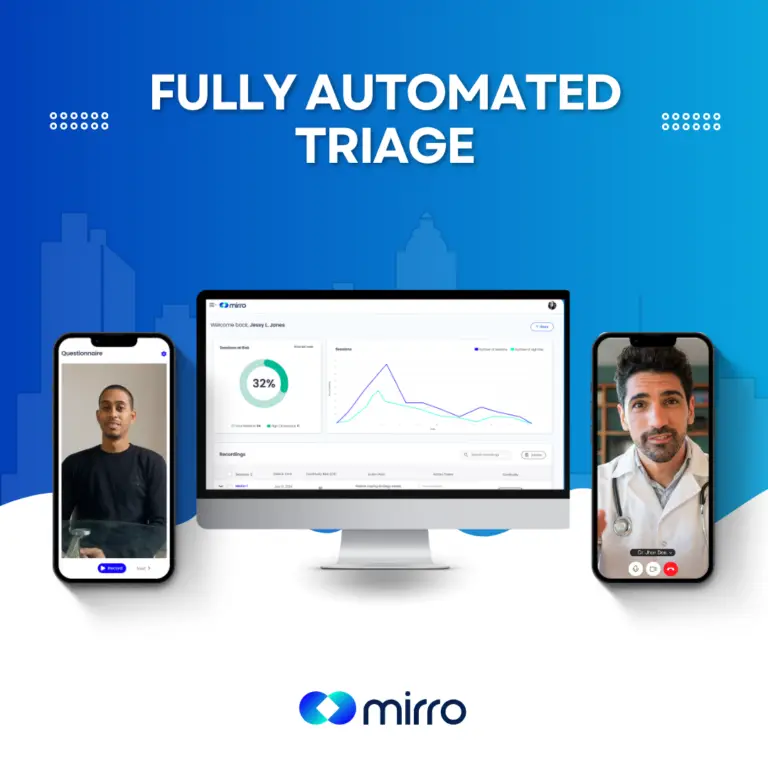
According to the Substance Abuse and Mental Health Services Administration (SAMHSA), 1 in 5 American adults experience a mental health condition each year.
In today’s hyper-connected world, where information travels in seconds, the need for timely and efficient mental health care is more pressing than ever. The advent of AI introduces new complexities, but it also brings unprecedented opportunities.
AI is advancing into every possible industry, and healthcare is no exception. However, this advancement should not be seen as a threat but as a powerful tool to improve human lives. The key is ethical use—leveraging AI for human advancement while ensuring compassion, care, and responsibility remain at the forefront of every innovation. In healthcare, and especially in telehealth and mental health services, the potential for AI’s impact is paramount.
With empathetic AI and 24/7 virtual triaging, we can bridge the growing gap between the increasing demand for mental health services and the limited availability of professionals. These technologies offer the unique ability to deliver care that is not only scalable and efficient but also deeply human, understanding the emotional and behavioral cues of patients and responding with empathy.
AI and Virtual Triage for Mental Health and Telehealth Platforms
With the mental health crisis escalating globally, virtual triaging has emerged as a critical solution for mental health care platforms.
The use of AI in mental health triaging provides several advantages:
24/7 Availability: Patients can access mental health care whenever they need it, no matter the time of day.
Actionable Insights for Clinicians: Empathetic AI provides deep emotional and behavioral insights, helping clinicians make informed decisions about a patient’s next steps.
Human-Centered Care: AI handles routine tasks and initial assessments, freeing up clinicians to focus on more complex, nuanced cases.
How mirro’s Empathetic AI Triages Mental Health Patients
mirro’s approach to virtual triaging is not just another AI-powered process. mirro’s omniEmotion™ AI surpasses typical sentiment analysis solutions by being truly multi-modal. mirro simultaneously considers tone, word usage, and facial expressions to capture emotional markers that single-modality AIs miss. It doesn’t just analyze what was said, but also how it was said and the non-verbal cues like gestures—even when a person is silent.
Here’s a step-by-step look at how mirro handles the triaging process:
- Clinician Sets the Stage: The clinician records a series of questions they would normally ask during an in-person assessment. These questions are personalized and designed to gather relevant information about the patient’s mental health. By sending these tailored questions in advance, clinicians create an opportunity for patients to respond at their own pace. This process allows patients to build comfort with their clinician before any direct interactions, helping to set a positive foundation for the therapeutic relationship. Patients can ease into the conversation from a familiar and comfortable environment, which reduces anxiety and fosters a sense of trust even before a live meeting takes place.
- Patient Completes the Triage Anytime: Patients can respond to these questions at their convenience. Whether they are at home or elsewhere, they have the freedom to take their time in answering.
- Mirro Analyzes Emotional and Behavioral Cues: Once the patient has responded, mirro’s empathetic AI goes to work. It doesn’t just analyze the content of the responses—it detects emotional states through voice tone, language patterns, and the depth of the responses.
- Actionable Insights Delivered to Clinicians: Based on the analysis, mirro provides clinicians with deep insights into the patient’s emotional and mental health state. These insights help the clinician determine the next course of action—whether that’s scheduling an in-person appointment, adjusting a treatment plan, or simply checking in.
- Continuous Follow-Up and Support: The AI-driven triage can also be used for routine follow-ups, ensuring that patients receive continuous care without placing extra strain on the clinician’s time.
The Human-in-the-Loop Approach: Balancing Technology with Compassion
The real strength of mirro’s AI lies in its human-in-the-loop design. While empathetic AI handles the heavy lifting of data analysis and triaging, it doesn’t replace the clinician. Instead, it augments their ability to deliver compassionate, informed care.
- For Patients: This means they receive immediate support through virtual triaging, reducing wait times and improving accessibility. Patients can share their thoughts and feelings in their own time, in a comfortable environment, without the pressure of an immediate response.
- For Clinicians: Mirro’s AI delivers a personalized snapshot of the patient’s emotional and mental health state, empowering clinicians with the data they need to provide targeted care. Additionally, mirro AI reduces the burden of administrative tasks like creating structured SOAP notes and Billing notes, freeing up time to focus on complex cases that require more attention.
- The challenge lies not in whether AI will be integrated into healthcare but how we choose to shape its role. By making AI work for us—ethically and empathetically—we can enhance both the patient and clinician experience, driving forward human-centered care in a rapidly evolving world.
